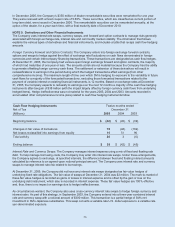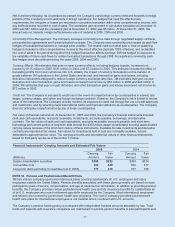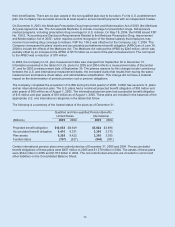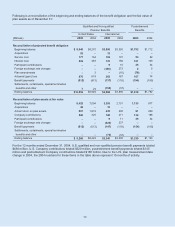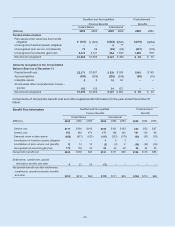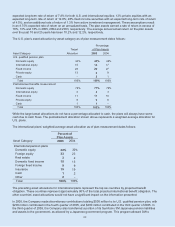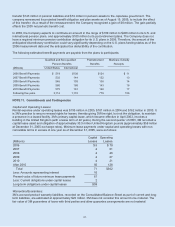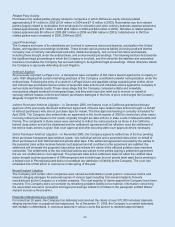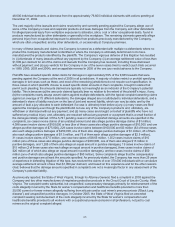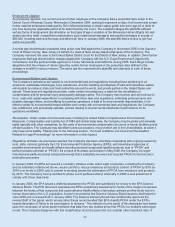3M 2005 Annual Report Download - page 92
Download and view the complete annual report
Please find page 92 of the 2005 3M annual report below. You can navigate through the pages in the report by either clicking on the pages listed below, or by using the keyword search tool below to find specific information within the annual report.
66
Employment Litigation
As previously reported, one current and one former employee of the Company filed a purported class action in the
District Court of Ramsey County, Minnesota in December 2004, seeking to represent a class of all current and certain
former salaried employees employed by 3M in Minnesota below a certain salary grade who were age 46 or older at
any time during the applicable period to be determined by the Court. The complaint alleges the plaintiffs suffered
various forms of employment discrimination on the basis of age in violation of the Minnesota Human Rights Act and
seeks injunctive relief, unspecified compensatory (up to triple actual damages) and punitive damages in excess of
$50,000, including back and front pay and attorneys’ fees. In January 2006, the plaintiffs filed a motion to join four
additional plaintiffs.
A similar age discrimination purported class action was filed against the Company in November 2005 in the Superior
Court of Essex County, New Jersey on behalf of a class of New Jersey-based employees of the Company. The
Company removed this case to the United States District Court for the District of New Jersey. In addition, three former
employees filed age discrimination charges against the Company with the U.S. Equal Employment Opportunity
Commission and the pertinent state agencies in Texas, Minnesota and California, during 2005. Such filings include
allegations that the release of claims signed by certain former employees in the purported class defined in the
charges is invalid for various reasons. The same law firm represents the plaintiffs and claimants in each of these
proceedings.
Environmental Matters and Litigation
The Company’s operations are subject to environmental laws and regulations including those pertaining to air
emissions, wastewater discharges, toxic substances, and the handling and disposal of solid and hazardous wastes
enforceable by national, state and local authorities around the world, and private parties in the United States and
abroad. These laws and regulations provide, under certain circumstances, a basis for the remediation of
contamination and for personal injury and property damage claims. The Company has incurred, and will continue to
incur, costs and capital expenditures in complying with these laws and regulations, defending personal injury and
property damage claims, and modifying its business operations in light of its environmental responsibilities. In its
effort to satisfy its environmental responsibilities and comply with environmental laws and regulations, the Company
has established, and periodically updates, policies relating to environmental standards of performance for its
operations worldwide.
Remediation: Under certain environmental laws, including the United States Comprehensive Environmental
Response, Compensation and Liability Act of 1980 and similar state laws, the Company may be jointly and severally
liable, typically with other companies, for the costs of environmental contamination at current or former facilities and at
off-site locations. The Company has identified numerous locations, most of which are in the United States, at which it
may have some liability. Please refer to the following section, "Accrued Liabilities and Insurance Receivables
Related to Legal Proceedings" for more information on this subject.
Regulatory Activities: As previously reported, the Company has been voluntarily cooperating with ongoing reviews by
local, state, national (primarily the U.S. Environmental Protection Agency (EPA)), and international agencies of
possible environmental and health effects of perfluorooctanyl compounds (perflurooctanoic acid or “PFOA” and
perfluorooctane sulfonate or “PFOS”). As a result of its phase-out decision in May 2000, the Company no longer
manufactures perfluorooctanyl compounds except that a subsidiary recovers and recycles PFOA for internal use in
production processes.
In January 2006, the EPA announced a voluntary initiative under which eight companies, including the Company
and its subsidiary referenced above, would commit to reduce emissions and product content of PFOA by 95% by
2010 over levels in 2000, and to commit to working toward the elimination of PFOA from emissions and products
by 2015. The Company having decided to phase out of perfluorooctanyl chemistry in 2000 is well positioned to
comply with these objectives.
In January 2005, the EPA issued a draft risk assessment for PFOA and submitted it for review to the EPA Science
Advisory Board. The EPA document expresses the EPA’s preliminary assessment in terms of the margin of exposure
between the levels of that compound that cause adverse health effects in laboratory animals and the levels found in
human blood sera in the U.S. population. A panel convened by the Science Advisory Board issued a draft report in
June 2005 and a revised draft in January 2006. The Science Advisory Board has conditionally approved the
revised draft of the panel, which among other things recommended that EPA classify PFOA under the EPA’s
hazard descriptor of “likely to be carcinogenic to humans.” The selection by the panel of this descriptor was based
upon the conclusion of some panel members that data from two studies show that PFOA is a multisite carcinogen
in rats. The Company disagrees with this classification since the panel did not consider other important data. A


